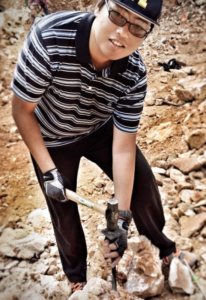
My work is to utilize computer technologies and data analytical methods to study Earth history and to bridge the gap between traditional geoscience research and fast-growing information technologies. I have been working on several different projects regarding various spatial and temporal scales. For example, I retrieved all available spatial data regarding paleoenvironment, stratigraphy, lithology, and dinosaur fossils of Cretaceous North America from APIs of Macrostrat and Paleobiology databases, and conducted spatiotemporal analysis. With all those data, I constructed a series of state-of-the-art time series of environments, lithological distributions, and the dinosaur diversity history in Cretaceous North America, and illustrated how the fossil preservation might be influenced by the paleoenvironment and sediment coverage. I found that the previous reconstructions of dinosaur diversity are biased by fossil sampling processes. Another example is that I mined large datasets of global temperature proxy data in the past 22,000 years from multiple sources, and processed them with spatiotemporal methods to put them into grids that cover the entire globe. In this way, I can visualize the spatial and temporal patterns of temperature anomalies since the Last Glacial Maximum, and compare proxy data to outputs of computer climate simulations in order to locate temperature discrepancies between the model and proxy data. Then, I am able to tell if the model is inaccurate at certain places or time during the Holocene, or if the proxy data are biased to a certain season of the year. I also wrote R and Python codes and develop ArcGIS/ArcPy workflows to automatize these processes. I am also a software developer working in a team building the Sparrow, a web-based, light-weight, and sophisticated data management system for geochronology and geochemistry labs. I am writing JavaScript codes to develop useful components for this software, such as the data importing function, the data submission form, and the interactive web map to locate any samples.
You can check out Shan’s personal website here.